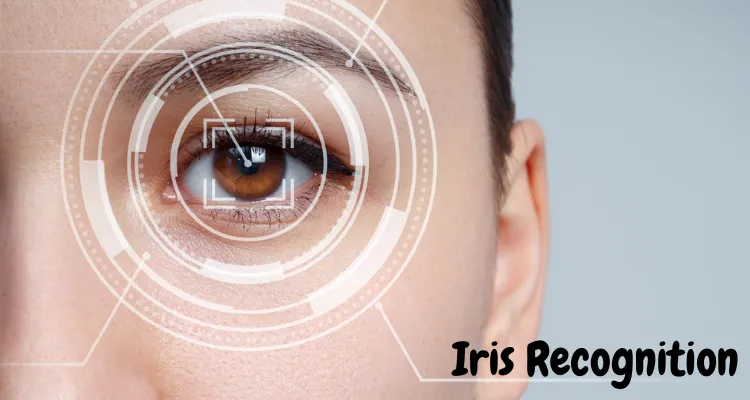Iris recognition is a biometric identification method that uses people’s distinctive iris patterns to identify them. The iris, which is the coloured portion of the eye that surrounds the pupil, is extremely complex and recognisable, making it a perfect biometric authentication indicator. Iris recognition technology has advanced over time and is now among the most precise and trustworthy biometric identification techniques. We will go into great detail on iris recognition in this blog article, including its anatomy and physiology, the method of iris recognition, benefits and drawbacks, applications, iris recognition systems, and iris recognition’s future.
I.Introduction Iris recognition technology exploits the distinctive features of the iris to identify people in a highly accurate and reliable biometric manner. Due to its high level of accuracy, quick identification process, and simplicity of use, it has grown in popularity in recent years. Applications for iris recognition technology include security and access control, law enforcement, healthcare, banking, and finance.
- The Eye: Anatomy and Physiology The iris, cornea, pupil, lens, retina, and other structures make up the complex organ known as the eye. The iris, which surrounds the pupil and is the coloured portion of the eye, is made up of muscles, pigments, and connective tissues. By changing the pupil’s size, the iris regulates how much light enters the eye. It also has distinctive qualities including patterns, colours, and textures that make it a perfect biometric identification.
III. The Iris Recognition Process Four steps are used by iris recognition technology to identify people. Taking a photograph of the iris using a high-resolution camera is the first stage in the process. The image is upgraded in the second step of the process to increase its quality and clarity. The third phase, feature extraction, involves identifying and extracting the distinctive qualities of the iris. The extracted features are compared to a database of stored iris patterns in the fourth stage, known as matching, in order to identify the person.
- Image acquisition: The first phase in the iris recognition process is picture acquisition, which involves taking a digital image of the iris with a dedicated camera. For the iris identification process to proceed successfully, the image acquisition stage’s quality is essential. When taking pictures, the subject should be told how to stand in relation to the camera and the camera should be positioned correctly. For precise feature extraction and matching, the camera should be able to capture images with sufficient resolution and sharpness. Additionally, the camera should be able to take pictures with a sufficient depth of field to include the entire iris, including the pupil and ciliary muscles.
For iris recognition, a variety of cameras are utilised, including budget webcams, smartphone cameras, and specialised iris cameras. Since they are made especially for iris identification and can take pictures in high resolution and under ideal lighting circumstances, specialised iris cameras are typically the best choice. Additionally, crucial are the lighting conditions at the time of image acquisition. To reduce glare, shadows, and other lighting artefacts that could degrade the image quality, the camera should be placed. The lighting should be sufficiently bright to reveal the iris, but not so intense as to irritate or harm the subject’s eyes.
- Image processing: The second phase in the iris identification process is image processing, which involves enhancing the digital image of the iris that was taken during image acquisition to improve its quality and clarity. To create a picture that can be used for feature extraction and matching in the later stages of iris identification is the aim of image processing. Several methods are used throughout the image processing stage, including noise reduction, normalisation, segmentation, and enhancement. These methods are employed to clean up any image artefacts, isolate the iris region, and improve the iris patterns in order to accurately extract features. The first step in image processing is noise reduction, which entails eliminating any noise or artefacts that might have been added during image acquisition. In order to smooth the image and remove noise, filters like median or Gaussian filters are frequently used.
In order to accurately extract and match features, the iris image must be normalised, or changed into a regular size and shape. The process of normalisation entails mapping the iris region to a circular template and standardising the iris’s proportions. The method of segmentation involves separating the iris region from the surrounding area of the image. Edge detection methods, such the Canny edge detector, are often used for this to identify the iris’ edges and eliminate any superfluous pixels. The next stage of image processing, enhancement, includes enhancing the iris patterns’ contrast and clarity. The brightness and contrast of the image are often adjusted using methods like histogram equalisation to make the iris patterns more visible.
- Feature extraction: The third phase in the iris recognition process, feature extraction, involves identifying and extracting distinctive iris features from the iris image. Then, using these characteristics, an iris template—a mathematical representation of the iris that can be compared to other iris templates—is produced. The texture, patterns, and edges of the iris are some of the characteristics that are employed in iris recognition. The placement of ridges, furrows, and other elements on the iris surface determines its texture. The radial furrows, collarette, and other elements close to the pupil shape the iris’s patterns. The iris-sclera junction, or the line separating the iris from the white of the eye, is what gives the iris its borders.
In order to extract features for iris recognition, a variety of methods are used, such as wavelet transforms, Gabor filters, and Daugman’s rubber sheet model. Using these methods, the iris’ distinctive traits are extracted, and an iris code—a binary representation of the iris’ features—is produced. The texture of the iris is examined, and the distinctive characteristics of the iris patterns are extracted, using wavelet transforms. By examining the frequency and direction of the iris characteristics, gabor filters are utilised to derive the iris texture. The mathematical Daugman rubber sheet model translates the iris patterns onto a two-dimensional surface and extracts the distinctive characteristics of the iris.
- Matching: The iris template formed during feature extraction is compared to other iris templates in a database during matching, which is the last stage in the iris recognition process. Finding out if the iris template being compared and the template in the database belong to the same person is the aim of matching. The binary iris code of the iris template being compared and the iris codes in the database are compared to find matches. The similarity between the two iris codes is commonly calculated using distance measures, such as Hamming distance or cosine similarity. The likelihood that two iris templates come from the same person increases with decreasing distance or increasing resemblance.
The quality of the iris image, the effectiveness of the feature extraction technique, and the size of the database, in addition to the distance metrics, can all have an impact on how accurate the matching is. Large databases may increase the likelihood of false positives and false negatives because it is more likely to locate comparable iris templates there. The Hamming distance method, the Mahalanobis distance algorithm, and the correlation-based approach are only a few of the matching algorithms utilised in iris recognition. These algorithms calculate the separation between the iris templates and locate a match using various methods.
- Benefits and Drawbacks of Iris Recognition The usage of iris recognition technology offers many benefits, such as high accuracy, a quick identification process, and simplicity. Additionally, it is a non-intrusive technique for biometric identification that avoids making direct touch with the person. It does have some drawbacks, though, such being expensive, requiring high-resolution cameras, and requiring the subject to be in close proximity to the camera.
- Utilising iris recognition applications Applications for iris recognition technology include security and access control, law enforcement, healthcare, banking, and finance. It is used in law enforcement applications to identify people, secure sensitive information, and manage access to restricted regions. It is employed in healthcare to recognise patients and gain access to their medical records. It is employed in banking and finance to safeguard financial transactions and stop fraud.
- Systems for iris recognition IriShield, Iris ID, and EyeLock are just a few of the iris recognition products on the market. These systems capture and recognise iris patterns using various technologies and techniques. These systems’ accuracy and dependability depend on a number of elements, including the calibre of the camera, the software employed, and the database of iris patterns.
VII. Iris Recognition’s Future Iris recognition technology has a bright future thanks to several developments and new trends. The use of machine learning and artificial intelligence to increase precision and speed, the incorporation of iris recognition with other biometric technologies, and the creation of mobile iris recognition devices are some of the prospective developments. The use of iris recognition in self-driving cars and other autonomous systems, as well as its integration with block chain technology for improved security, are among the developing developments.











